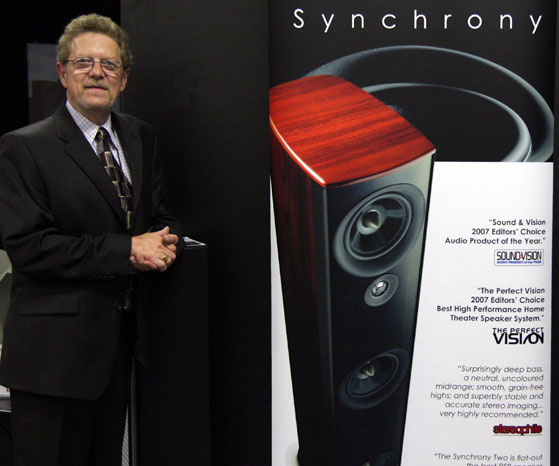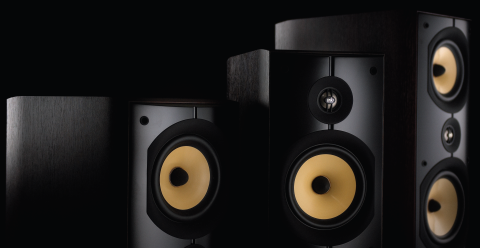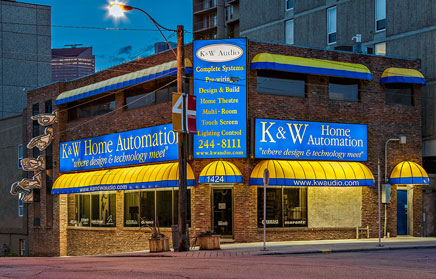K&W Audio (Enthusiastically) Welcomes PSB
“Voice-matching” or “Timbre-matching” are terms that are bandied about quite liberally in the world of surround sound and, unfortunately, a lot of speaker manufacturers don’t do it as well as they should.
The premise is simple: As sound moves from one speaker to another in a surround field, that sound should NOT undergo any drastic alterations. The more seamless the transitions are, the greater the illusion that there are no speakers at all, just you, the listener, is transported to this new environment—be it a smoky little jazz club in Paris, the bridge of a starship, or a tropical jungle in Southeast Asia. When speakers aren’t matched properly, the individual boxes start to stand out and it makes it impossible to forget that you’re in your living room, surrounded by boxes that are spitting out sounds only slightly related to one another. It becomes particularly noticeable when you want to enjoy your CD collection using some of the music surround modes that are offered by most receivers and processors.
Try this experiment with your system at home: Start off by playing your favorite CD in straight stereo—no surround speakers, no center speaker, just good ol’ analog left & right 2-channel stereo, and take note of the vocal quality of the lead singer. Now switch to “Pro-Logic II Music” or “DTS Neo6 Music” and listen to the same song (or disc) again. Go ahead, I’ll wait ‘til you get back. . . . . . .Well? How’d it go? If your system is properly matched and properly set up, then it should have sounded slightly better—but not drastically different—the second time through. If, on the other hand, the lead singer sounded choked, or the sound stage seemed to compress into the center speaker, that’s probably a good indication that your center speaker isn’t matched up as well as it should be to your mains, and that’s NOT YOUR FAULT! The truth is, a lot of speaker manufacturers put out speakers that are supposedly voice matched, but honestly don’t keep pace with your mains.
WE HAVE A SOLUTION. K&W Audio is proud to announce a new addition to our family of fine audio and home theater products and its name is PSB. Paul Barton (that’s the P and the B, the S is for his wife, Sue, because behind every great audiophile is a woman who tolerates him) has been one of Canada’s foremost speaker designers for over 30 years and with his new “Synchrony” series of loudspeakers he has really knocked it out of the park. What really stands out with the PSB Synchrony speakers is that they don’t just pay lip service to the idea of voice matching, they achieve it with a finesse that surpasses most, if not all other challengers. The only time you’ll hear speakers match more closely is in systems that use identical speakers throughout (an impossibility in most living rooms). PSB has given us the same timbre quality with 2 floor standing towers and a smaller, horizontally configured center speaker as well as a choice of surrounds.

The designer and his finest work
Just listening to the Synchrony speakers in stereo is a mind-numbingly beautiful escape from drab reality. The bass is powerful and authoritative but well balanced, never bloated or boomy. The midrange smooth and uncolored and the detailed highs create a soundstage with credible height and depth, but the best part is now, when you switch from listening in stereo to listening in Neo 6 or PL IIX, the sound doesn’t distort or get all weird, it just gets bigger and better.
There are 2 choices for the center speaker, the Synchrony 1c and the 2c, the one being slightly larger and more robust. To match up with those, you simply decide on bookshelf or tower: the 1 is a tower, the 1b is a bookshelf, both match the 1c. Then there’s a 2 (tower), 2b (bookshelf), hey it doesn’t always have to be complicated. For surround speakers, you can either go with the bookshelf models or PSB’s unique bi-polar surrounds. They’re unique in that the front and rear faces of the speakers are equipped with independent connections on the back of the speaker, which means that they can be configured as bi-polar (in phase front & back) di-polar (out of phase front to back) or connected as two separate speakers to the amp or receiver—allowing you to achieve true 7 speaker surround from only 5 boxes. If that last part has you confused, don’t feel bad, we actually had to read the manual before we absorbed that little tidbit.
The fit & finish of the PSB speakers is nothing short of a work of art and they look particularly good in the dark cherry finish (though they are also available in *yawn* black). For a speaker that sounds this good and looks as good as it sounds, the PSB is a tremendous value, despite the fact that a 7 speaker package could run as much as $11,700.00 for the top of the line and that’s not even including a subwoofer. We firmly believe these speakers hold their own against others costing 2 and 3 times as much.
As if that wasn’t enough, we also have decided to bring into the fold the smaller siblings to the Synchronies, the Image and Imagine speaker lines. They are equally outstanding in their price categories and well worth a listen for anyone in the market for a truly well matched surround system or a great, musical 2-channel experience.





